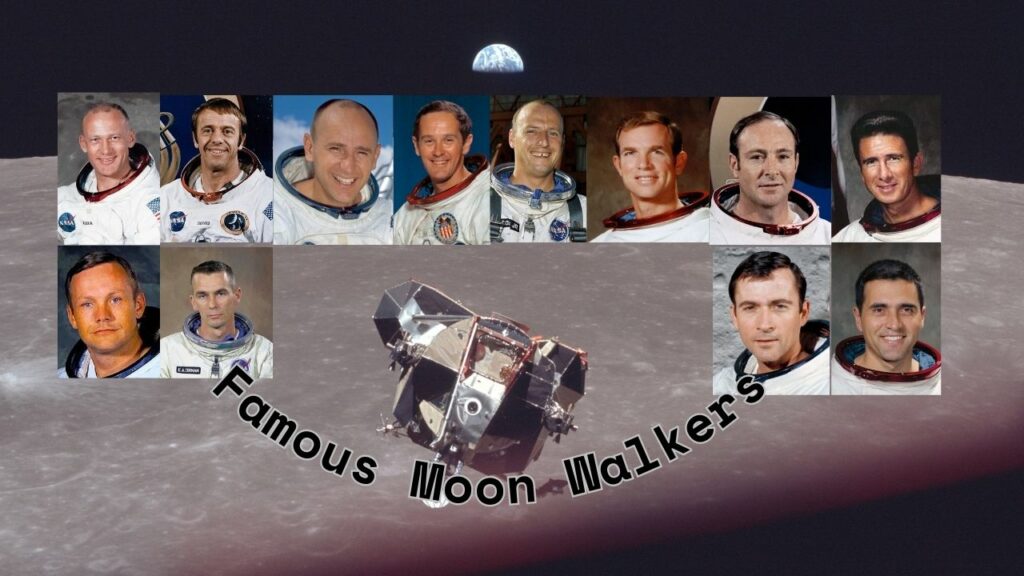
This weeks top 10 countdown actually has 12 names on it! That’s right. Only 12 famous astronauts walked on the moon, so I included them all! Although the list is “ranked”, it is from first to walk on the moon, to the last.
Controversy surrounding walking on the Moon
The notion that the moon landings were a hoax orchestrated by the United States government has been a persistent conspiracy theory since the late 1960s. Despite overwhelming evidence supporting the authenticity of the Apollo missions, a subset of skeptics continues to question the veracity of this monumental achievement. It’s crucial to emphasize that these claims lack credibility and are widely debunked by experts in various fields, including astronomy, physics, and engineering.
One of the central arguments presented by moon landing deniers is the contention that the photographs and videos captured during the Apollo missions were staged on Earth. Critics often point to perceived anomalies in the images, such as shadows appearing inconsistent or the absence of stars in the lunar sky. However, these discrepancies can be explained by the unique conditions of the lunar environment, where the lack of atmosphere affects lighting and visibility. Experts in photography and imaging have consistently refuted these claims, providing detailed analyses that confirm the authenticity of the visuals.
Another common argument revolves around the perceived impossibility of human survival in the harsh radiation of space. Moon landing deniers often assert that the Van Allen radiation belts surrounding Earth would have posed insurmountable risks to the Apollo astronauts. However, spacecraft trajectories, mission durations, and protective measures implemented by NASA were carefully calculated to minimize exposure to radiation. Moreover, the radiation encountered during the brief transit through the Van Allen belts was within acceptable limits for human space travel.
Skeptics also question the feasibility of the technology available in the 1960s to accomplish such a complex mission. The argument posits that the computing power of that era was insufficient for the precise calculations required for a moon landing. In reality, the Apollo missions harnessed state-of-the-art technology at the time, and NASA’s meticulous planning and execution, coupled with the brilliance of engineers and scientists, ensured the success of the missions.
A critical aspect of the conspiracy theory involves the alleged absence of independent verification. Moon landing deniers often claim that the footage and data could have been manipulated by NASA without external scrutiny. However, the Apollo missions were tracked by a network of observatories and independent organizations worldwide, including those in countries with no political affiliation to the United States. The fact that the Soviet Union, a Cold War rival, never contested the moon landings serves as a powerful testament to the credibility of the missions.
In conclusion, the moon landing conspiracy theory lacks a foundation in scientific evidence and is overwhelmingly debunked by experts in relevant fields. The moon landings stand as a remarkable testament to human ingenuity, determination, and technological prowess. The enduring legacy of the Apollo missions is one of the greatest achievements in the history of space exploration, grounded in the pursuit of knowledge and the advancement of humanity’s understanding of the cosmos.
Summary List of Famous Astronauts who Walked on Moon
- Neil Armstrong (Apollo 11): Neil Armstrong was the first person to set foot on the moon on July 20, 1969. As the commander of Apollo 11, his iconic words “That’s one small step for [a] man, one giant leap for mankind” marked a historic moment in human space exploration.
- Buzz Aldrin (Apollo 11): Buzz Aldrin, the lunar module pilot for Apollo 11, followed Neil Armstrong onto the lunar surface. He conducted scientific experiments and played a crucial role in the success of the mission.
- Charles Conrad (Apollo 12): Charles “Pete” Conrad was the commander of Apollo 12, the sixth person to walk on the moon. He and Alan Bean explored the lunar surface and conducted experiments during their mission in November 1969.
- Alan Bean (Apollo 12): Alan Bean, the lunar module pilot for Apollo 12, accompanied Conrad on the moon. After his astronaut career, Bean became an accomplished artist, capturing his experiences on canvas.
- Alan Shepard (Apollo 14): Alan Shepard, the commander of Apollo 14, was the first American in space and the fifth person to walk on the moon. His mission in 1971 included the deployment of scientific instruments and the collection of lunar samples.
- Edgar Mitchell (Apollo 14): Edgar Mitchell, the lunar module pilot for Apollo 14, joined Shepard on the moon. He conducted experiments and was known for his interest in the paranormal and consciousness research after leaving NASA.
- David Scott (Apollo 15): David Scott served as the commander of Apollo 15 in 1971. He and James Irwin conducted geological experiments and were the first to use the lunar rover for extended exploration on the moon’s surface.
- James Irwin (Apollo 15): James Irwin, the lunar module pilot for Apollo 15, conducted geological studies on the moon alongside Scott. He also became an advocate for Christian evangelical activities after leaving NASA.
- John Young (Apollo 16): John Young, the commander of Apollo 16, was the ninth person to walk on the moon. He and Charles Duke explored the lunar highlands and collected a variety of samples during their 1972 mission.
- Charles Duke (Apollo 16): Charles Duke, the lunar module pilot for Apollo 16, explored the moon with Young. He is known for being the youngest person to walk on the lunar surface at the age of 36.
- Eugene Cernan (Apollo 17): Eugene Cernan, the commander of Apollo 17, was the last person to walk on the moon in December 1972. His famous words as he left the lunar surface were, “We leave as we came, and, God willing, as we shall return, with peace and hope for all mankind.”
- Harrison Schmitt (Apollo 17): Harrison Schmitt, the lunar module pilot for Apollo 17, was a geologist and the only professional scientist to walk on the moon. He and Cernan conducted extensive geological experiments during their mission.
Official Top 12 Countdown of famous astronauts who walked on the moon
12. Harrison Schmitt (Apollo 17)
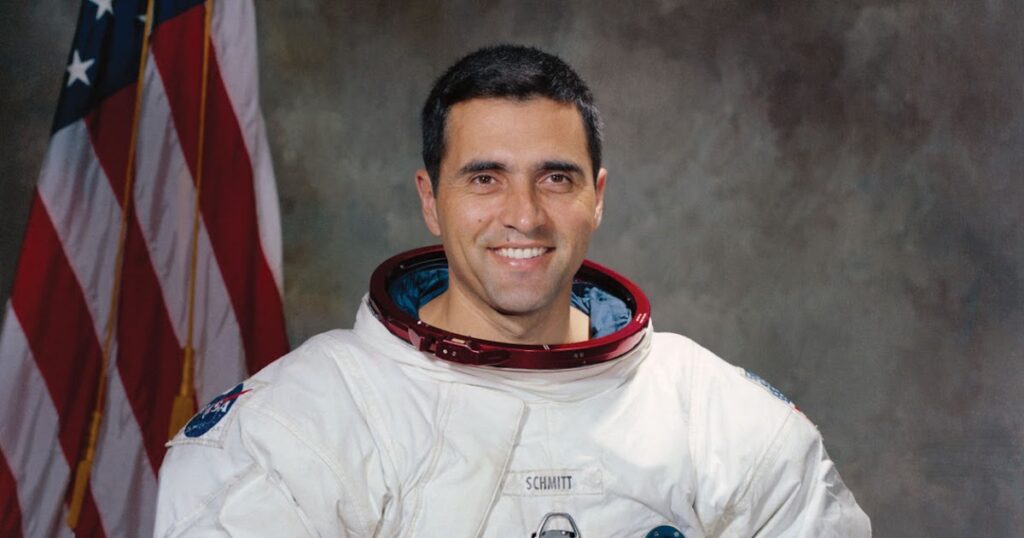
Harrison Schmitt, born on July 3, 1935, in Santa Rita, New Mexico, USA, and is still alive. As the lunar module pilot for Apollo 17, Schmitt became the last person to walk on the moon, concluding the Apollo program.
Ten Interesting Facts About Harrison Schmitt:
- Geological Expertise: Harrison Schmitt, a professional geologist, brought unique scientific expertise to the Apollo program, playing a crucial role in the success of Apollo 17’s geological experiments.
- NASA Selection: Selected as an astronaut in 1965, Schmitt’s background in geology made him a valuable asset for lunar exploration missions.
- Lunar Discovery: Schmitt discovered orange soil on the moon, revealing the presence of volcanic material and providing important insights into lunar geology.
- Long-duration Mission: Apollo 17, the longest Apollo mission, saw Schmitt spending over 22 hours on the lunar surface, conducting experiments and collecting samples.
- Political Career: After NASA, Schmitt entered politics, serving as a U.S. Senator from New Mexico (1977-1983), offering a unique perspective as an astronaut in the political arena.
- Global Impact: Advocating for space exploration and resource utilization beyond Earth, Schmitt continues to contribute to discussions on lunar mining and settlement.
- Scientific Legacy: Beyond his lunar contributions, Schmitt has authored works on space exploration, geology, and climate change, maintaining his presence in the scientific community.
- Educational Background: Schmitt earned his Ph.D. in geology from Harvard University before joining NASA, highlighting his academic prowess in lunar geology.
- Apollo 17’s Last Steps: The departure of Schmitt and Eugene Cernan from the lunar surface on December 14, 1972, marked the conclusion of human missions to the moon.
- Advocacy for Mars Exploration: An advocate for human exploration of Mars, Schmitt emphasizes Mars as a key to understanding the solar system’s origins and potential for extraterrestrial life.
Conclusion:
Harrison Schmitt’s geological expertise significantly contributed to our understanding of the moon’s composition. As the final astronaut to walk on the lunar surface, his role in Apollo 17 marks the conclusion of a historic era in space exploration. Beyond his astronautic achievements, Schmitt’s political career and ongoing advocacy continue to shape discussions on the future of lunar and Martian exploration.
11. Eugene Cernan (Apollo 17)
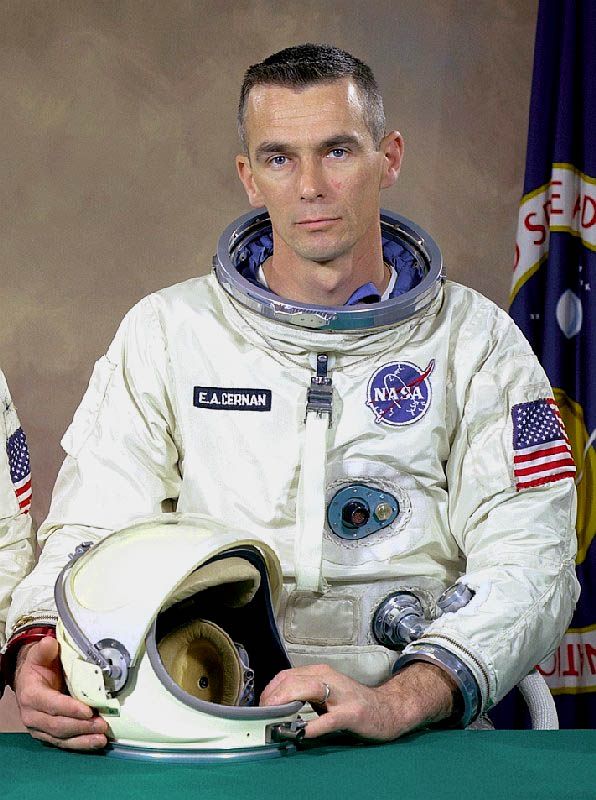
Introduction: Eugene Cernan, born on March 14, 1934, in Chicago, Illinois, USA, passed away on January 16, 2017. As the commander of Apollo 17, Cernan became the last person to walk on the moon, concluding the Apollo program.
Ten Interesting Facts About Eugene Cernan:
- Naval Aviator: Before joining NASA, Cernan served as a naval aviator, accumulating over 5,000 flight hours and piloting various aircraft, including the F-4 Phantom.
- Gemini and Apollo Veteran: Cernan flew in space three times, including as the pilot of Gemini IXA and as the lunar module pilot on Apollo 10 before commanding Apollo 17.
- Lunar Module Pilot on Apollo 10: Cernan descended to within nine miles of the lunar surface during Apollo 10’s lunar module test, a crucial step before the actual moon landing missions.
- Spacewalk Record: During Gemini IXA, Cernan set a record for the longest extravehicular activity (EVA) at that time, spending over two hours outside the spacecraft.
- Last Steps on the Moon: On December 14, 1972, Cernan became the last person to leave the lunar surface, marking the end of human exploration on the moon to date.
- Educational Background: Cernan earned a Bachelor of Science in Electrical Engineering from Purdue University and a Master of Science in Aeronautical Engineering from the U.S. Naval Postgraduate School.
- Post-Apollo Career: After leaving NASA, Cernan entered the private sector and became an entrepreneur. He also served as a television commentator during subsequent space missions.
- Advocate for Space Exploration: Cernan was a passionate advocate for space exploration, emphasizing the importance of continued human exploration beyond Earth’s orbit.
- Honors and Awards: Cernan received numerous honors, including the Navy Distinguished Flying Cross, the NASA Distinguished Service Medal, and the Presidential Medal of Freedom.
- Legacy of “The Last Man on the Moon”: Cernan’s autobiography, “The Last Man on the Moon,” and the documentary of the same name, capture his experiences and contribute to preserving the legacy of Apollo-era astronauts.
Conclusion:
Eugene Cernan’s legacy as the last person to walk on the moon is etched in history. His distinguished career as a naval aviator, his contributions to early space missions, and his advocacy for continued space exploration have left an indelible mark on the space community. Cernan’s life serves as a testament to human ingenuity and exploration, inspiring future generations to reach for the stars.
10. Charles Duke (Apollo 16)
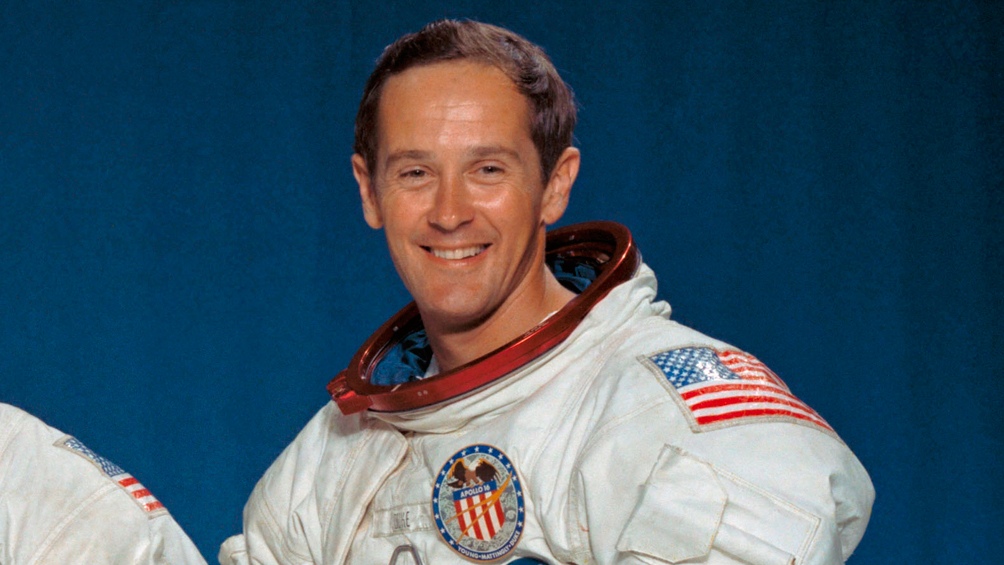
Introduction: Charles Moss Duke, born on October 3, 1935, in Charlotte, North Carolina, USA, and is still alive. Charles Duke was the lunar module pilot for Apollo 16, where he became the tenth person to walk on the moon.
Ten Interesting Facts About Charles Duke:
- Youngest Person on the Moon: Charles Duke holds the record as the youngest person to walk on the moon, stepping onto the lunar surface at the age of 36 during the Apollo 16 mission in 1972.
- Military Background: Duke served as a United States Air Force officer, accumulating over 4,000 hours of flying time in jet aircraft before joining NASA.
- NASA Selection: Selected as an astronaut in 1966, Duke was a part of the astronaut support crew for Apollo 11 and served as backup lunar module pilot for Apollo 13 before his own lunar mission.
- Lunar Olympics: During Apollo 16, Duke and John Young conducted a “Lunar Olympics,” where they performed high jumps and other activities to explore the effects of low gravity.
- Religious Experience: After his return from the moon, Duke became a born-again Christian. He left a photograph of his family on the lunar surface, and he later became active in Christian ministry.
- Post-Apollo Career: Duke had a successful post-NASA career, working in business and later serving as the president of the Duke Investments Corporation.
- Educational Background: Duke earned a Bachelor of Science in Naval Sciences from the United States Naval Academy and a Master of Science in Aeronautics and Astronautics from the Massachusetts Institute of Technology (MIT).
- Apollo 16 Mission: The Apollo 16 mission included extensive lunar surface exploration, collecting samples, and deploying scientific instruments to study the moon’s geology.
- Spacewalk Records: Duke and Young conducted three moonwalks during Apollo 16, spending a total of about 20 hours on the lunar surface.
- Honors and Awards: Charles Duke has received various honors, including the NASA Distinguished Service Medal and the Air Force Distinguished Service Medal.
Conclusion:
Charles Duke’s distinction as the youngest person to walk on the moon highlights his significant role in the Apollo program. His post-mission activities, from religious experiences to a successful business career, demonstrate the diverse impact of moonwalkers beyond their time at NASA. Duke’s contributions to space exploration and subsequent endeavors reflect the spirit of exploration that defines humanity’s journey beyond Earth.
9. John Young (Apollo 16)
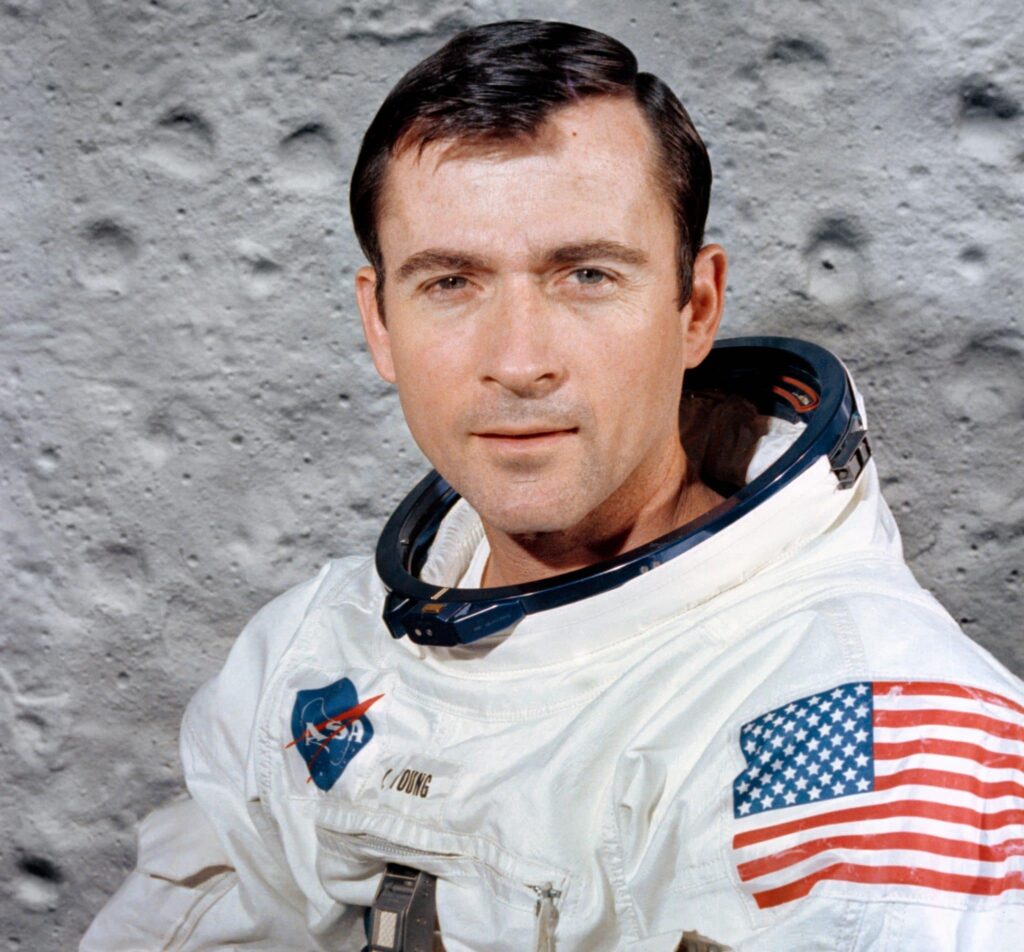
Introduction: John Watts Young, born on September 24, 1930, in San Francisco, California, USA, passed away on January 5, 2018. John Young was the commander of Apollo 16, and his remarkable career spanned over four decades at NASA, making him the longest-serving astronaut.
Ten Interesting Facts About John Young:
- NASA’s Longest-Serving Astronaut: John Young joined NASA in 1962 and holds the record as the agency’s longest-serving astronaut, with a career that included six spaceflights over 42 years.
- Space Shuttle Pioneer: Young commanded the inaugural space shuttle flight, STS-1, in 1981, making him the first person to fly in space six times and the only astronaut to pilot, command, and walk on the moon.
- Test Pilot Career: Before becoming an astronaut, Young was a U.S. Navy test pilot, flying a wide variety of aircraft, and he set several world records for speed and altitude.
- Apollo 16 Mission Commander: As the commander of Apollo 16, Young and Charles Duke explored the lunar surface for nearly three days, conducting experiments and collecting samples.
- Moonwalk Record: Young and Duke conducted three moonwalks during Apollo 16, spending a total of about 20 hours on the lunar surface.
- Orbital Maneuvers Expert: Young’s skills in orbital mechanics were crucial during the Apollo 10 mission, where he performed critical maneuvers to test the lunar module in lunar orbit, paving the way for the moon landing.
- Space Shuttle Innovations: Young played a key role in developing the space shuttle and contributed to the design of the Space Shuttle Orbiter, earning him the Presidential Medal of Freedom.
- Educational Background: Young earned a Bachelor of Science in Aeronautical Engineering from the Georgia Institute of Technology.
- STS-9 Mission: On the STS-9 mission, Young served as commander of the Spacelab mission, further demonstrating his versatility in spaceflight.
- Post-NASA Career: After retiring from NASA in 2004, Young continued to advocate for space exploration, emphasizing the importance of returning to the moon and reaching Mars.
Conclusion:
John Young’s unparalleled contributions to NASA’s space programs, from his early days as a test pilot to commanding historic missions like Apollo 16 and the first space shuttle flight, shaped the agency’s trajectory. His legacy as a space pioneer, record-holder, and advocate for exploration underscores the profound impact of his career on the history of space exploration.
8. James Irwin (Apollo 15)
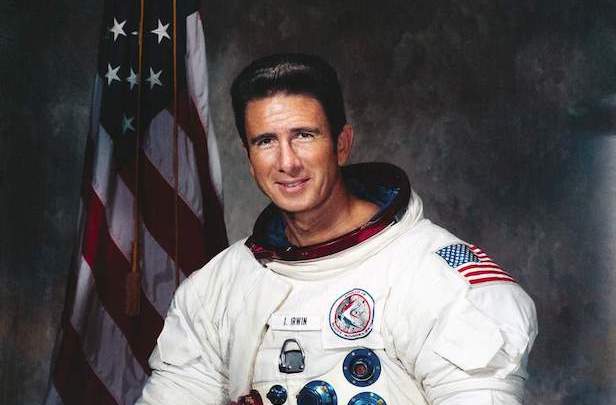
Introduction: James Benson Irwin, born on March 17, 1930, in Pittsburgh, Pennsylvania, USA, passed away on August 8, 1991. As the lunar module pilot for Apollo 15, Irwin became the eighth person to walk on the moon.
Ten Interesting Facts About James Irwin:
- Air Force Pilot: Irwin served as a fighter pilot in the United States Air Force, logging over 7,000 hours of flight time in various aircraft before joining NASA.
- NASA Selection: Selected as an astronaut in 1966, Irwin was a member of the support crew for Apollo 10 before his assignment to Apollo 15.
- Apollo 15 Mission: Irwin’s mission with David Scott on Apollo 15 in 1971 was the first to include the use of the lunar rover, allowing for extended exploration and sample collection.
- Lunar Module Pilot: As the lunar module pilot, Irwin descended to the moon’s surface with Scott while the command module orbited above.
- Scientific Contributions: Irwin conducted scientific experiments on the moon’s surface, including deploying the first Lunar Roving Vehicle, and collected valuable geological samples.
- Heart Problems on the Moon: Irwin experienced heart issues during the Apollo 15 mission, leading to concerns about his ability to complete the lunar activities. However, he performed his duties successfully.
- Religious Experience: Irwin described his time on the moon as a profoundly spiritual experience. After his return, he founded the High Flight Foundation, emphasizing the connection between science and faith.
- Educational Background: Irwin earned a Bachelor of Science in Naval Science from the United States Naval Academy.
- Post-Apollo Career: After leaving NASA, Irwin dedicated himself to Christian ministry, conducting several missions to Mount Ararat in search of Noah’s Ark.
- Honors and Awards: Irwin was awarded the NASA Distinguished Service Medal and the United States Air Force Distinguished Service Medal for his contributions to space exploration.
Conclusion:
James Irwin’s unique experience on the moon, coupled with his spiritual reflections, added a profound dimension to the Apollo 15 mission. His contributions to lunar science and the use of innovative technologies, such as the lunar rover, expanded the scope of human exploration on the moon. Irwin’s post-NASA endeavors reflect his deep commitment to both scientific exploration and spiritual pursuits, leaving a lasting legacy in both realms.
7. David Scott (Apollo 15)
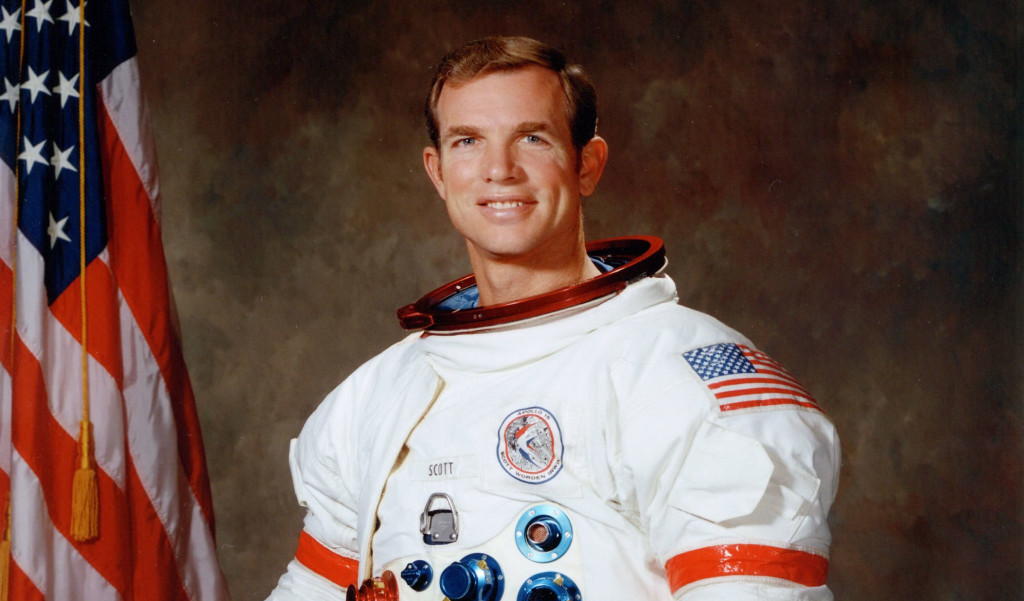
Introduction: David Randolph Scott, born on June 6, 1932, in San Antonio, Texas, USA, and is still alive. As the commander of Apollo 15, Scott played a pivotal role in advancing lunar exploration.
Ten Interesting Facts About David Scott:
- Military Career: Scott began his career as an officer in the United States Air Force, where he logged over 5,600 hours of flying time in various aircraft.
- NASA Selection: Selected as an astronaut in 1963, Scott flew on Gemini 8 before commanding Apollo 9, the first crewed mission to test the lunar module.
- Apollo 15 Mission: As the commander of Apollo 15 in 1971, Scott and James Irwin conducted extensive lunar surface exploration, utilizing the first Lunar Roving Vehicle to cover greater distances.
- Lunar Module Commander: Scott served as the commander of the lunar module while Irwin descended to the moon’s surface. He also piloted the command module during the mission.
- Jettisoning the Hammer and Feather: On the moon, Scott performed a famous experiment, dropping a geologic hammer and a feather at the same time to demonstrate Galileo’s theory of falling objects in a vacuum.
- Spacewalk Record: Scott set a record for the longest spacewalk during the Apollo program, spending 6 hours and 22 minutes outside the spacecraft during Apollo 9.
- Postage Stamp Incident: Scott faced controversy after the Apollo 15 mission when he carried unauthorized postage stamps to the moon, intending to sell them later. This led to reprimands but did not overshadow the scientific success of the mission.
- Educational Background: Scott earned a Bachelor of Science in Military Science from the United States Military Academy at West Point and a Master of Science in Aeronautics and Astronautics from the Massachusetts Institute of Technology (MIT).
- Post-Apollo Career: After leaving NASA, Scott held various positions in the aerospace industry. He also wrote books and engaged in educational outreach, sharing his experiences.
- Honors and Awards: Scott received numerous awards, including the NASA Distinguished Service Medal and the Air Force Distinguished Service Medal.
Conclusion:
David Scott’s command of Apollo 15 marked a significant step forward in lunar exploration, with the mission incorporating advanced scientific tools and technologies. His leadership, both in space and during the subsequent investigation into the postage stamp incident, reflects the complexities of human endeavors beyond Earth. Scott’s dedication to education and outreach underscores the importance of sharing the experiences of space exploration with future generations.
6. Edgar Mitchell (Apollo 14)
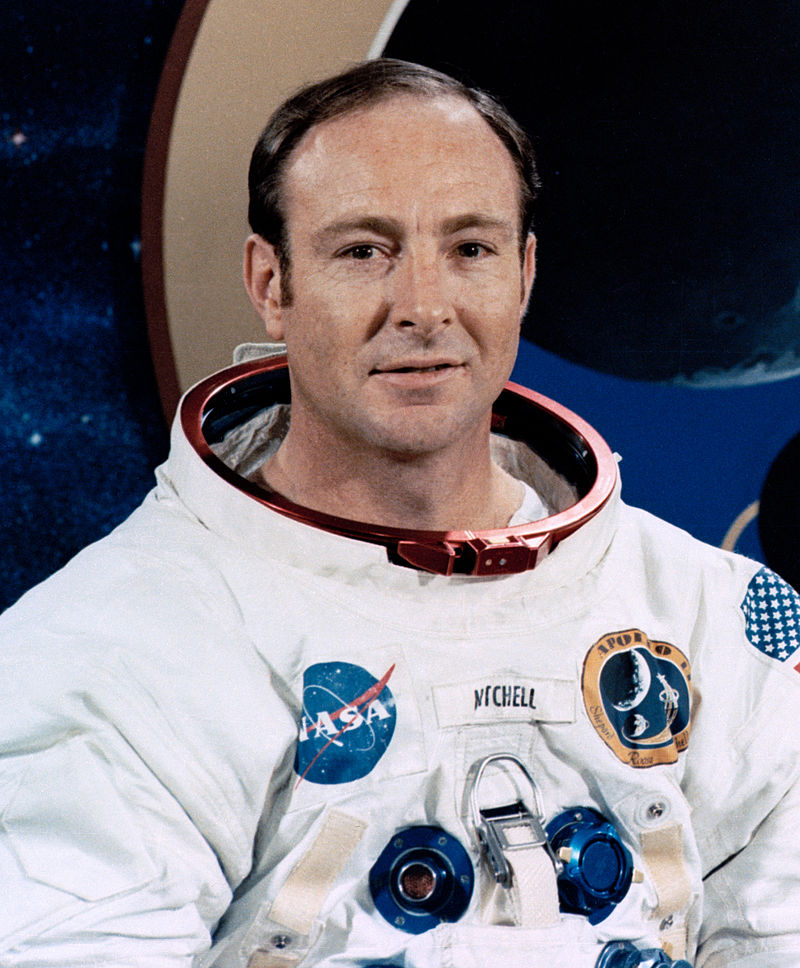
Introduction: Edgar Dean Mitchell, born on September 17, 1930, in Hereford, Texas, USA, passed away on February 4, 2016. As the lunar module pilot for Apollo 14, Mitchell became the sixth person to walk on the moon.
Ten Interesting Facts About Edgar Mitchell:
- Naval Officer: Before joining NASA, Mitchell served as a naval officer, with a background as a test pilot and an instructor at the United States Naval Test Pilot School.
- NASA Selection: Selected as an astronaut in 1966, Mitchell flew on Apollo 14 in 1971, following his time as the backup lunar module pilot for Apollo 10.
- Apollo 14 Mission: Mitchell and Alan Shepard conducted the third successful moon landing, spending about nine hours on the lunar surface, conducting experiments and collecting samples.
- Lunar Module Pilot: As the lunar module pilot, Mitchell piloted the lunar module to the surface while Shepard descended to the moon. They also performed two moonwalks.
- Spacewalk Record: Mitchell set a record for the longest spacewalk during Apollo 14, spending 9 hours and 23 minutes on the lunar surface.
- Studies in Consciousness: After his astronaut career, Mitchell pursued studies in human consciousness, parapsychology, and metaphysics, founding the Institute of Noetic Sciences.
- Post-Apollo Career: Mitchell was involved in various business ventures and served on the boards of several companies. His interest in space exploration and consciousness persisted throughout his life.
- Educational Background: Mitchell earned a Bachelor of Science in Industrial Management from the Carnegie Institute of Technology (now Carnegie Mellon University) and a Doctor of Science in Aeronautics and Astronautics from the Massachusetts Institute of Technology (MIT).
- Technological Innovations: Mitchell was a proponent of technological innovations and alternative energy solutions, advocating for sustainable practices and environmental awareness.
- Honors and Awards: Mitchell received the Presidential Medal of Freedom, the NASA Distinguished Service Medal, and the Navy Distinguished Service Medal.
Conclusion:
Edgar Mitchell’s contributions extend beyond the realm of space exploration, encompassing his interest in consciousness and sustainability. His dedication to exploring the mysteries of the mind and the universe reflects the broader perspectives that some astronauts developed after their lunar experiences. Mitchell’s multifaceted career serves as an example of the diverse paths taken by those who have ventured into the unknown reaches of space.
5. Alan Shepard (Apollo 14)
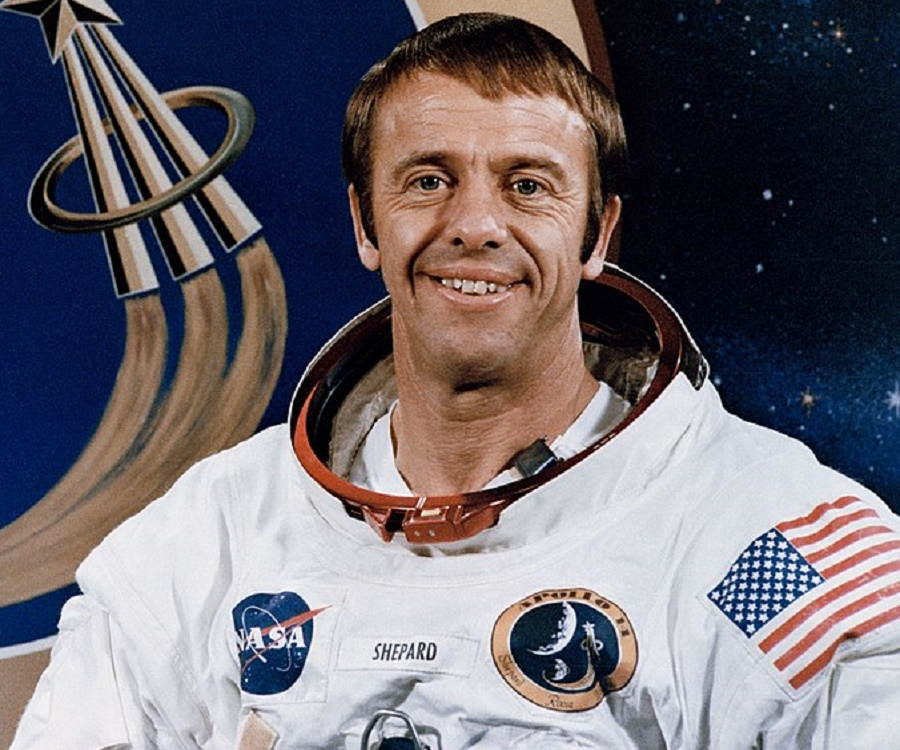
Introduction: Alan Bartlett Shepard Jr., born on November 18, 1923, in Derry, New Hampshire, USA, passed away on July 21, 1998. Shepard was a pioneering American astronaut and the commander of Apollo 14, marking his historic return to space after being the first American in space on the Freedom 7 suborbital mission in 1961.
Ten Interesting Facts About Alan Shepard:
- First American in Space: On May 5, 1961, Shepard made history as the first American to travel to space aboard the Freedom 7 spacecraft, reaching an altitude of 116 miles and experiencing a brief suborbital flight.
- Naval Aviator: Shepard had a distinguished career as a naval aviator, logging over 8,000 flight hours in various aircraft, including high-speed test flights.
- NASA Mercury and Apollo Missions: Shepard was one of the original NASA Mercury 7 astronauts. After his historic suborbital flight, he underwent surgery for an inner ear disorder, leading to a temporary hiatus. He returned to space as the commander of Apollo 14 in 1971.
- Apollo 14 Moonwalk: Shepard, along with Edgar Mitchell, spent about nine hours on the lunar surface during the Apollo 14 mission, conducting experiments, collecting samples, and famously hitting golf balls with a makeshift club.
- Sixth Person on the Moon: As the commander of Apollo 14, Shepard became the sixth person to walk on the moon on February 5, 1971, demonstrating the progress of American space exploration.
- Skilled Golfer: Shepard’s golfing on the moon, using a specially designed six-iron head attached to a lunar sample scoop handle, became an iconic moment of the Apollo program.
- Post-Apollo Career: After retiring from NASA in 1974, Shepard pursued various business ventures. He also became the first astronaut to enter the U.S. Senior PGA Tour.
- Educational Background: Shepard earned a Bachelor of Science in Naval Sciences from the United States Naval Academy.
- Medals and Honors: Shepard received several honors, including the Congressional Space Medal of Honor and the Navy Distinguished Service Medal.
- Legacy: Alan Shepard’s legacy extends beyond his space achievements, representing the courage and pioneering spirit of early space exploration. His contributions laid the groundwork for future manned missions and inspired generations of astronauts.
Conclusion:
Alan Shepard’s journey from the first American in space to the commander of Apollo 14 exemplifies his resilience and dedication to space exploration. His historic golf swing on the lunar surface added a touch of humor to the serious business of lunar exploration. Shepard’s legacy lives on as a trailblazer and symbol of American space achievements.
4. Alan Bean (Apollo 12)
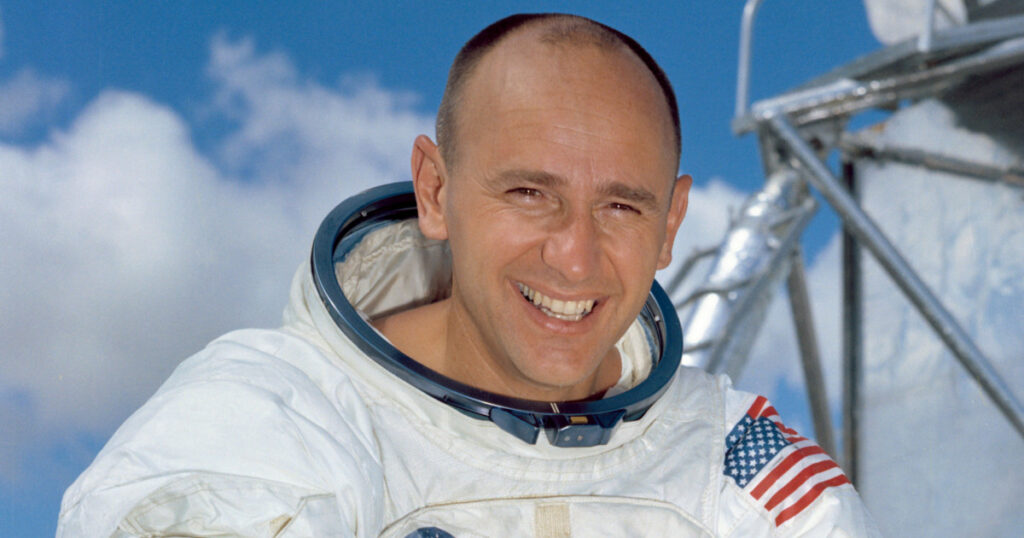
Introduction: Alan LaVern Bean, born on March 15, 1932, in Wheeler, Texas, USA, passed away on May 26, 2018. As the lunar module pilot for Apollo 12, Bean became the fourth person to walk on the moon.
Ten Interesting Facts About Alan Bean:
- Navy Test Pilot: Before joining NASA, Bean had a distinguished career as a naval aviator and a test pilot in the United States Navy.
- NASA Selection: Selected as an astronaut in 1963, Bean flew on Gemini 11 before serving as the lunar module pilot for Apollo 12 in 1969.
- Apollo 12 Moonwalk: Bean, along with Charles Conrad, spent about 7 hours on the lunar surface during the Apollo 12 mission, conducting experiments and collecting samples.
- Artist Astronaut: After retiring from NASA in 1981, Bean pursued a career as an artist. His paintings capture his experiences on the moon and offer a unique perspective on space exploration.
- Fourth Person on the Moon: Bean was the fourth person to walk on the moon, stepping onto the lunar surface just minutes after Charles Conrad during the Apollo 12 mission.
- Commander of Skylab Mission: Bean served as the commander of the Skylab 3 mission in 1973, spending 59 days in space. Skylab was the United States’ first space station.
- Educational Background: Bean earned a Bachelor of Science in Aeronautical Engineering from the University of Texas at Austin.
- Impacts Experiment: Bean conducted an experiment on the moon called the “Apollo Lunar Surface Experiments Package,” studying the effects of micrometeoroid impacts on the lunar surface.
- Post-NASA Art Career: Bean’s artistic endeavors included painting scenes from space and creating a series of limited-edition prints. His unique perspective as an artist-astronaut added depth to his post-NASA contributions.
- Legacy of Exploration: Alan Bean’s legacy extends beyond his time on the moon, showcasing the fusion of science and art. His artworks and contributions to space exploration continue to inspire a broader appreciation for the wonders of the cosmos.
Conclusion:
Alan Bean’s transition from astronaut to artist reflects the multidimensional nature of those who have ventured into space. His lunar exploration and subsequent artistic expressions provide a unique perspective on the human experience of space travel. Bean’s legacy lives on in both the scientific and artistic realms, enriching our understanding of the moon and the broader cosmos.
3. Charles “Pete” Conrad (Apollo 12)
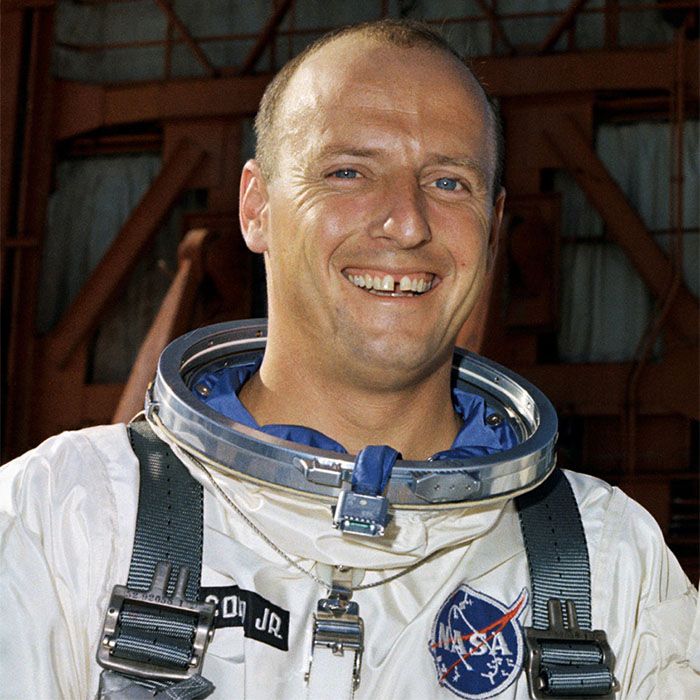
Introduction: Charles “Pete” Conrad Jr., born on June 2, 1930, in Philadelphia, Pennsylvania, USA, passed away on July 8, 1999. Conrad was the commander of Apollo 12, the third person to walk on the moon, and he played a crucial role in advancing human lunar exploration.
Ten Interesting Facts About Charles “Pete” Conrad:
- Naval Aviator: Before joining NASA, Conrad served as a naval aviator, accumulating over 4,800 flight hours in various aircraft, including fighter jets and patrol bombers.
- NASA Selection: Selected as an astronaut in 1962, Conrad flew on Gemini 5 and Gemini 11 before commanding the Apollo 12 mission in 1969.
- Apollo 12 Moonwalk: Conrad, along with Alan Bean, spent about 7 hours on the lunar surface during the Apollo 12 mission, conducting experiments, deploying scientific instruments, and collecting samples.
- Surveyor 3 Visit: Apollo 12 successfully landed near the Surveyor 3 spacecraft, and Conrad and Bean conducted a brief visit to inspect and retrieve parts from Surveyor 3, providing valuable data on the effects of the lunar environment.
- Third Person on the Moon: Conrad was the third person to walk on the moon, following Neil Armstrong and Buzz Aldrin. His famous words upon stepping onto the lunar surface were, “Whoopee! Man, that may have been a small one for Neil, but that’s a long one for me.”
- Apollo 11 Backup Commander: Conrad served as the backup commander for Apollo 11, making him a crucial figure in the early stages of the Apollo program.
- Skylab Missions: Conrad commanded the Skylab 2 mission in 1973, spending 28 days in space. Skylab marked the first U.S. space station.
- Educational Background: Conrad earned a Bachelor of Science in Aeronautical Engineering from Princeton University.
- Post-NASA Career: After leaving NASA, Conrad pursued a career in the private sector, including working for McDonnell Douglas Aerospace. He also remained an advocate for space exploration.
- Legacy of Leadership: Conrad’s leadership skills and calm demeanor during the unexpected lightning strike shortly after Apollo 12’s launch demonstrated his ability to handle challenging situations in space.
Conclusion:
Charles “Pete” Conrad’s contributions to the Apollo program and lunar exploration, particularly as the commander of Apollo 12, showcased his leadership and problem-solving skills. His role in recovering parts from Surveyor 3 and his subsequent command of Skylab missions solidified his legacy as a key figure in the early years of human spaceflight. Conrad’s impact on space exploration, both as an astronaut and advocate, continues to be celebrated in the annals of space history.
2. Buzz Aldrin (Apollo 11)
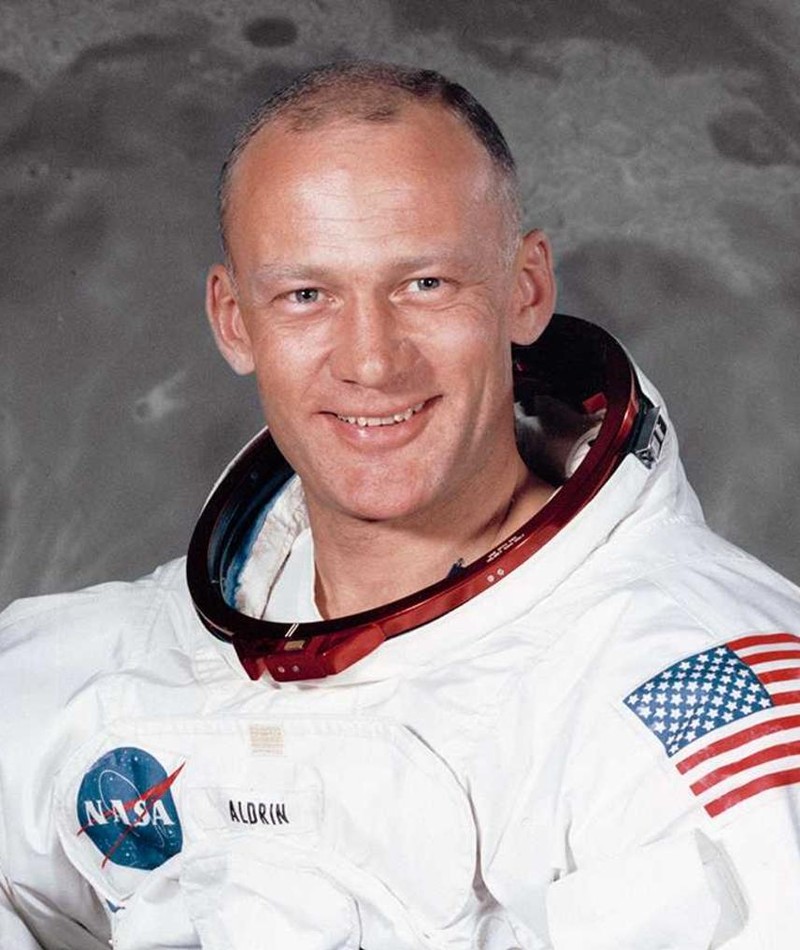
Introduction: Edwin Eugene “Buzz” Aldrin Jr., born on January 20, 1930, in Glen Ridge, New Jersey, USA, and is still alive. Buzz Aldrin was the lunar module pilot for Apollo 11, the historic mission that successfully landed the first humans on the moon.
Ten Interesting Facts About Buzz Aldrin:
- NASA Selection: Buzz Aldrin, a U.S. Air Force colonel, was selected as an astronaut in 1963. He piloted the Gemini 12 spacecraft on the final Gemini mission before being assigned to Apollo 11.
- Second Person on the Moon: On July 20, 1969, Buzz Aldrin and Neil Armstrong became the first and second humans to walk on the moon during the Apollo 11 mission. Aldrin followed Armstrong onto the lunar surface.
- Apollo 11 Moonwalk: Aldrin spent about 2 hours and 15 minutes outside the lunar module, conducting experiments and collecting samples during the iconic moonwalk.
- Educational Background: Aldrin earned a Bachelor of Science in Mechanical Engineering from the United States Military Academy at West Point. He later earned a Doctor of Science in Astronautics from the Massachusetts Institute of Technology (MIT).
- Spacewalk Record: During the Gemini 12 mission, Aldrin set a record for the longest spacewalk at that time, spending over 5 hours outside the spacecraft.
- Post-NASA Career: After retiring from NASA in 1971, Aldrin wrote several books, became an advocate for space exploration, and even made guest appearances in popular media, including a cameo on “The Simpsons.”
- Phobos Monolith: Aldrin proposed the concept of a monolith on the moon Phobos, one of Mars’ moons. His idea suggested using Phobos as a base for crewed missions to Mars.
- Awards and Honors: Aldrin received numerous honors, including the Presidential Medal of Freedom, the Congressional Gold Medal, and the NASA Distinguished Service Medal.
- Advocacy for Mars Exploration: Buzz Aldrin has been a vocal proponent of future human exploration of Mars, proposing a plan known as the “Aldrin Mars Cycler.”
- Cycling Path to Mars: Aldrin’s Mars Cycler concept envisions spacecraft continuously cycling between Earth and Mars, providing a potential framework for sustainable transportation for Mars missions.
Conclusion:
Buzz Aldrin’s legacy is firmly embedded in the monumental achievement of being one of the first humans to set foot on the moon. His contributions to space exploration extend beyond his historic moonwalk, encompassing advocacy for future missions to Mars and ongoing efforts to inspire the next generation of space enthusiasts. Buzz Aldrin remains a symbol of human exploration and achievement in the vastness of space.
1. Neil Armstrong (Apollo 11)
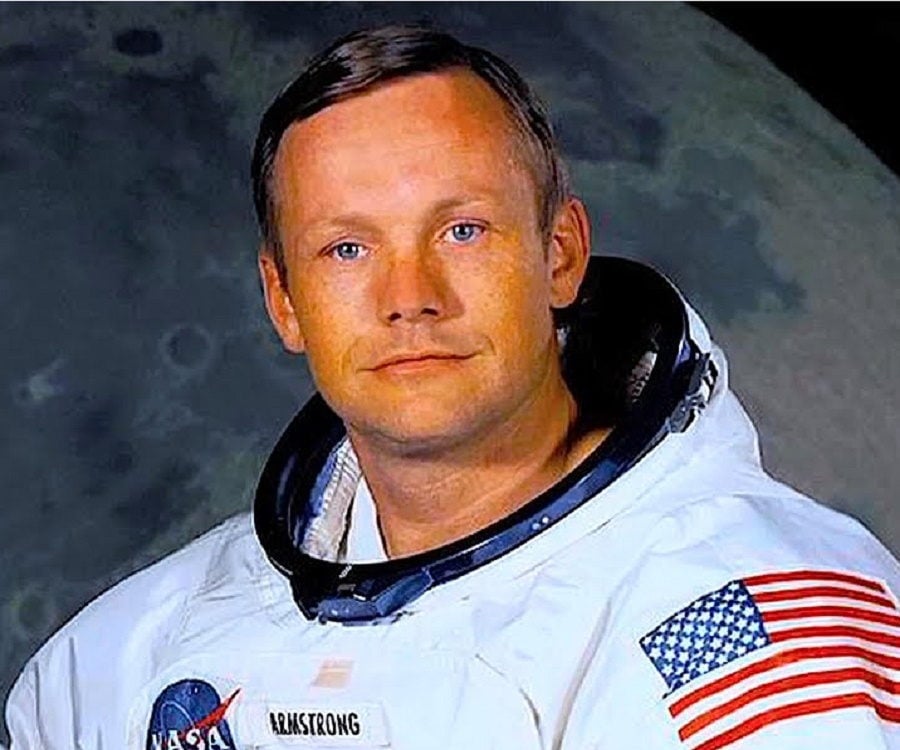
Introduction: Neil Alden Armstrong, born on August 5, 1930, in Wapakoneta, Ohio, USA, passed away on August 25, 2012. Armstrong was the commander of Apollo 11, and he made history as the first person to walk on the moon on July 20, 1969.
Ten Interesting Facts About Neil Armstrong:
- NASA Selection: Neil Armstrong, a former U.S. Navy officer and test pilot, was selected as an astronaut in 1962. He flew on the Gemini 8 mission before being chosen as the commander for Apollo 11.
- First Human on the Moon: On July 20, 1969, Armstrong set foot on the lunar surface, delivering the famous words, “That’s one small step for [a] man, one giant leap for mankind,” as millions around the world watched the historic event.
- Apollo 11 Moonwalk: Armstrong and Buzz Aldrin spent approximately 2 hours and 15 minutes outside the lunar module, conducting experiments, collecting samples, and planting the American flag.
- Eagle Lunar Module: Armstrong piloted the lunar module, named Eagle, to a safe landing on the moon, overcoming challenges during the descent and making a manual landing with seconds of fuel remaining.
- NASA’s X-15 Test Pilot: Before joining NASA, Armstrong was a test pilot, including flying the X-15 rocket plane, where he achieved altitudes of over 200,000 feet and speeds of over Mach 5.
- Educational Background: Armstrong earned a Bachelor of Science in Aeronautical Engineering from Purdue University and a Master of Science in Aerospace Engineering from the University of Southern California.
- Gemini 8 Mission: Armstrong’s piloting skills were crucial during the Gemini 8 mission when he successfully averted a near-disastrous spacecraft roll caused by a malfunctioning thruster.
- Post-NASA Career: After leaving NASA in 1971, Armstrong taught aerospace engineering at the University of Cincinnati and served on various corporate boards. He maintained a relatively private life.
- Presidential Medal of Freedom: Armstrong received the Presidential Medal of Freedom, the highest civilian award in the United States, for his contributions to space exploration.
- Legacy of Exploration: Neil Armstrong’s historic moonwalk and his contributions to space exploration made him an enduring symbol of human achievement. He paved the way for further exploration beyond Earth and inspired generations of scientists and dreamers.
Conclusion:
Neil Armstrong’s significance in the annals of space exploration cannot be overstated. His monumental steps on the lunar surface represent not only a giant leap for mankind but also a testament to human ingenuity and the relentless pursuit of knowledge. Armstrong’s legacy continues to inspire and serves as a beacon for those who seek to explore the mysteries of the cosmos.
Did you enjoy this countdown? Check out our other Top 10 Famous Folks lists, or see other Famous Explorers like these famous astronauts who walked on the moon.
